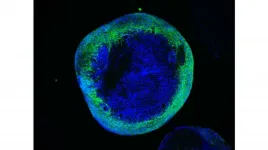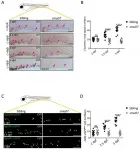Climate change significantly increases population displacement risk
2021-03-26
(Press-News.org) Every year, millions of people around the world are displaced from their homes due to severe weather caused by climate change. According to the International Red Cross and Red Crescent Movement, 10.3 million people were displaced as a result of climate-?related events in the last six months alone - four times the number displaced by war and conflict in the same period. One of the main causes of displacement is flooding. A recent example is the situation in eastern Australia, where tens of thousands of people are having to flee their homes to seek safety from this hundred-?year flood.
An international research team led by the Weather and Climate Risks Group at ETH Zurich has just published a new study aimed at providing a better understanding of future displacement risks due to flooding from rivers overflowing their banks. Their study also evaluates the influence of climate change as well as demographic and socioeconomic factors on these risks.
Population growth greatly increases risk
Using a variety of climate, hydrology and population distribution models, the researchers show that if the population remains stable at its current level, the risk of flood-?related displacement increases by more than 50 percent (relative to 2010 levels) for each degree of global warming.
However, the world's population is growing. Even if this growth continues towards a more sustainable path, the risk of displacement will still increase significantly: assuming that the world meets the Paris Agreement's goal of limiting global warming to a maximum of 2° Celsius, the globally averaged risk is projected to rise by up to 110 percent by the end of this century.
However, under "business as usual" climate-?change conditions and if the gap between rich and poor continues to widen, the risk is projected to increase even more dramatically. For this scenario, the researchers calculated that the risk of displacement due to flooding would be up to 350 percent higher.
Rapid action needed
According to the study's authors, it is not yet too late to address and manage the risk of flood displacement through spatial and urban planning measures and protective infrastructure such as dams. "Our findings highlight the need for rapid action on both climate mitigation and adaptation agendas in order to reduce future risks, especially to vulnerable populations," says Pui Man Kam, lead author of the study and doctoral student in ETH Professor David N. Bresch's group. "Floods often affect the most socio-?economically vulnerable groups, who tend to live in more hazard-?prone areas," she explains.
To conduct their study, the researchers used a global climate-?, hydrology-? and inundation-?modelling chain to quantify the effect of global warming on displacement risk for both current and projected future population distributions. The study has just been published in the journal Environmental Research Letters.
"Because floods are a major driver of displacement and due to the fact that they are influenced by climate change, it is imperative that we have a better understanding of how the risks are changing," Kam says.
INFORMATION:
Reference
Kam PM, Aznar-?Siguan G, Schewe J, Milano L, Ginnetti J, Willner S, McCaughey JW, Bresch DN: Global warming and population change both heighten future risk of human displacement due to river floods. Environmental Research Letters, 24 March 2020, doi: 10.1088/1748-?9326/abd26c
ELSE PRESS RELEASES FROM THIS DATE:
2021-03-26
The skin is the largest organ in the human body, and its outermost part, called the epidermis, is replenished every three weeks. The cells fueling this renewal of the epidermal stem cells, found in specialized areas or niche, within a region of the hair follicle (or root) is known as the 'bulge compartment'. The bulge compartment resident stem cells are multipotent meaning that they can contribute to the repair of skin when it's injured, and also regenerate the hair follicles during normal development. While several groups have focused attention on the stem cells themselves, less is known about niche or extrinsic factors that influence the state of these stem cells.
In the recent paper published in the Developmental Cell, ...
2021-03-26
Leigh syndrome is the most severe mitochondrial disease in children. It causes severe muscle weakness, movement defects, and intellectual disabilities. It usually leads to death within the first years of life. No causative treatment is currently available. One of the genes frequently mutated in patients is SURF1, which encodes for a protein involved in the process of energy generation in the cells. Animal models did not recapitulate the defects seen in the patients carrying mutations in SURF1. Therefore, the scientists did not have the tool to start understanding the disease mechanisms and to identify possible targets for treatment. They report about the first ...
2021-03-26
Apple flies have fascinated scientists right from the mid-19th century, as they are a captivating example of speciation, the beginning of a new species. Correspondence between Charles Darwin and Benjamin Walsh, who observed the apple flies and hawthorn flies in North America, began the rich history of this scientific question in evolutionary biology. When settlers in North America introduced apple trees to the region, what happened within the hawthorn flies to make them shift to this new host plant in the last 300 years?
Continuing the 160-year-old inquiry into the origins of the apple fly, a team of scientists from around the world has just published their research in the Proceedings of the Royal Society B. The researchers span three continents, from the National Centre for Biological ...
2021-03-26
Hematopoietic stem/progenitor cells (HSPCs) include hematopoietic stem cells and several lineage-biased hematopoietic progenitor cells, which can provide all blood cell types in an adult organism. Among them, hematopoietic stem cells have the ability of self-renewal and multi-lineage differentiation, and can rapidly respond under acute hematopoietic conditions. Meanwhile, the hematopoietic progenitor cells can maintain the supply of blood cells in homeostatic hematopoiesis. In a word, HSPCs are the core of the blood system, once their homeostasis is destroyed, it will lead to serious blood diseases and even death. Therefore, the researches associated with the HSPCs can provide a strong support for relevant ...
2021-03-26
Almost all wild canines in Australia are genetically more than half dingo, a new study led by UNSW Sydney shows - suggesting that lethal measures to control 'wild dog' populations are primarily targeting dingoes.
The study, published today in Australian Mammalogy, collates the results from over 5000 DNA samples of wild canines across the country, making it the largest and most comprehensive dingo data set to date.
The team found that 99 per cent of wild canines tested were pure dingoes or dingo-dominant hybrids (that is, a hybrid canine with more than 50 per cent dingo genes).
Of the remaining ...
2021-03-26
Irvine, Calif., March 25, 2021 -- A short-term intervention in daily fiber consumption can significantly alter the gut microbiome and nutrient intake, according to a study led by University of California, Irvine researchers. The research was recently published by the American Society for Microbiology.
Dietary fiber consists of resistant carbohydrates found in fruits, vegetables and whole grains. Fiber persists in our digestion system, and while not digestible by humans, our gut bacteria can metabolize fiber into short-chain fatty acids and other byproducts critical to human health.
Currently, the average person in North America consumes less than 50 percent of the recommended dietary ...
2021-03-26
Water scarcity is often understood as a problem for regions experiencing drought, but a new study led by Tufts University researchers finds that not only can localized water shortages impact the global economy, but changes in global demand can have positive and negative ripple effects in river basins across the globe.
In addition to Tufts engineers, the team included experts from the Joint Global Change Research Institute at the Pacific Northwest National Laboratory, and Cornell University.
"We're finding that water scarcity dynamics are more complicated than traditionally acknowledged," said Flannery Dolan, a graduate student ...
2021-03-26
International genomics research led by the University of Leicester has used artificial intelligence (AI) to study an aggressive form of cancer, which could improve patient outcomes.
Mesothelioma is caused by breathing asbestos particles and most commonly occurs in the linings of the lungs or abdomen. Currently, only seven per cent of people survive five years after diagnosis, with a prognosis averaging 12 to 18 months.
New research undertaken by the Leicester Mesothelioma Research Programme has now revealed, using AI analysis of DNA-sequenced mesotheliomas, that they evolve along similar or repeated paths between individuals. These paths predict the aggressiveness and possible therapy of this otherwise incurable cancer.
Professor ...
2021-03-26
Bottom Line: Various genetic alterations in circulating tumor cells (CTCs) were associated with clinical outcomes and resistance to hormone therapy in patients with metastatic castrate-resistant prostate cancer (mCRPC).
Journal in Which the Study was Published: Molecular Cancer Research, a journal of the American Association for Cancer Research
Author: Andrew Armstrong, MD, MSc, a medical oncologist at the Duke Cancer Institute Center for Prostate and Urologic Cancers at Duke University
Background: While only a minority of men with mCRPC have primary resistance to the androgen receptor (AR) inhibitors enzalutamide (Xtandi) or abiraterone acetate (Yonsa or Zytiga), most men will ...
2021-03-26
A study with first-time learners of Japanese has measured how brain activity changes after just a few months of studying a new language. The results show that acquiring a new language initially boosts brain activity, which then reduces as language skills improve.
"In the first few months, you can quantitatively measure language-skill improvement by tracking brain activations," said Professor Kuniyoshi L. Sakai, a neuroscientist at the University of Tokyo and first author of the research recently published in Frontiers in Behavioral Neuroscience.
Researchers followed 15 volunteers as they moved to Tokyo and completed introductory Japanese classes for at least three hours each day. All volunteers ...
LAST 30 PRESS RELEASES:
[Press-News.org] Climate change significantly increases population displacement risk





